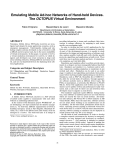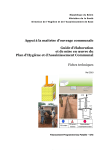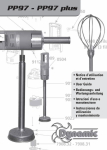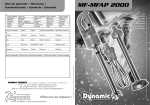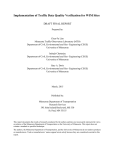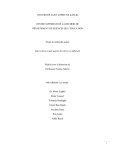Download Lebanese University Faculty of Engineering II Final year project
Transcript
Lebanese University Faculty of Engineering II Final year project Submitted in fulfillment of the requirements for the Mechanical Engineering Degree By ANTONIOS Elie SABBAGH Elie Automatic Small Éclaté Project supervisors: Dr. Rany RIZK Dr. Ziad YAMMINE 2012 Lebanese University-Faculty of Engineering 2 Mechanical Department Automatic Small Eclate Acknowledgments The success of any project depends largely on the encouragement and guidelines of many others. We take this opportunity to express our gratitude to the people who have been instrumental in the successful completion of this project. We would like to show our greatest appreciation to Dr. Ziad Yammine and Dr. Rany Rizk. We can’t say thank you enough for their tremendous support and help. Without their encouragement and guidance, this project would not have materialized. The guidance and support received from all the members who contributed especially Mr. Georges Bassila, was vital for the success of the project. We are grateful for their constant support and help. Finally, yet importantly, we would like to express our heartfelt thanks to our beloved parents for their blessings, our friends and classmates for their help and wishes for the Acknowledgments successful completion of this project. 1 Lebanese University-Faculty of Engineering 2 Mechanical Department Automatic Small Eclate Abstract This document presents a concept design of an automated small 'éclaté' machine after eliminating several proposals on different basis: feasibility, efficiency… In addition, the design and execution of a Swing Cutter machine which necessity appeared during the study of the project. The small 'éclaté' machine already exists in manual mode. The project consists of executing an automated machine that takes small stone blocks parallelepiped shaped to produce 'éclaté' stones ready to use. The project starts with introducing the 'éclaté' stones then presents several ways to automate the loading, splitting and cutting processes. After that, an elimination procedure of several proposals took place to attempt a final design simple and feasible. This same course of action was adopted to design the “Swing Cutter”. This project presents an overview of the design process for both machines from stress analysis of critical parts to the sizing of each actuator. Abstract Finally, hydraulic and electrical designs are presented along with the PLC ladder diagram and the PID closed loop control. 2 Lebanese University-Faculty of Engineering 2 Mechanical Department Automatic Small Eclate Contents Acknowledgments ................................................................................................................ 1 Abstract................................................................................................................................. 2 LIST OF FIGURES.................................................................................................................... 5 2 3 Introduction ................................................................................................................. 6 1.1 Types of stone: ..................................................................................................... 6 1.2 Conventional splitting machines: ......................................................................... 6 1.3 New concept: ........................................................................................................ 7 Pre-processing.............................................................................................................. 9 2.1 Existing formula: ................................................................................................... 9 2.2 New experiment: .................................................................................................. 9 Blades system ............................................................................................................ 12 3.1 Simple blades: ..................................................................................................... 12 3.2 Multi-blades system: .......................................................................................... 12 3.2.1 Mechanical multi-blades system:................................................................ 13 3.2.2 Hydraulic multi-blades system: ................................................................... 13 3.3 4 5 Single hinged blade:............................................................................................ 14 3.3.1 Design: ......................................................................................................... 15 3.3.2 Stress analysis:............................................................................................. 15 3.3.3 Conclusion: .................................................................................................. 17 Chassis ........................................................................................................................ 18 4.1 Design: ................................................................................................................ 18 4.2 Stress analysis: .................................................................................................... 18 Block centering .......................................................................................................... 20 5.1 Introduction: ....................................................................................................... 20 5.2 Proposals: ........................................................................................................... 20 5.2.1 Proposal A: .................................................................................................. 20 5.2.2 Proposal B:................................................................................................... 21 5.2.3 Proposal C:................................................................................................... 22 5.2.4 Proposal D: .................................................................................................. 22 5.2.5 Proposal E: ................................................................................................... 23 5.2.6 Proposal F: ................................................................................................... 23 5.2.7 Proposal G: .................................................................................................. 24 5.3 Comparison:........................................................................................................ 24 5.4 Final design: ........................................................................................................ 25 Abstract 1 3 Lebanese University-Faculty of Engineering 2 Mechanical Department 5.4.1 6 Automatic Small Eclate Final sketch: ................................................................................................. 25 Swing Cutter ............................................................................................................... 27 6.1 Object ................................................................................................................. 27 6.2 Requirements ..................................................................................................... 27 6.3 Mechanical design .............................................................................................. 28 6.3.1 Preprocessing: sketch.................................................................................. 28 6.3.2 Force analysis .............................................................................................. 29 6.3.3 Cutting motor .............................................................................................. 29 6.3.4 Holding bars ................................................................................................ 30 6.3.5 Plates ........................................................................................................... 31 6.3.6 The shaft ...................................................................................................... 32 6.3.7 Bearings Selection ....................................................................................... 35 6.3.8 Design of the table ...................................................................................... 36 6.3.9 Design of the chassis ................................................................................... 37 6.3.10 Saw disc cover ............................................................................................. 38 6.3.11 Unloading rods ............................................................................................ 39 6.3.12 Water cooling system .................................................................................. 39 6.4 6.4.1 Concept study.............................................................................................. 40 6.4.2 Proposals ..................................................................................................... 42 6.5 Electric design ..................................................................................................... 44 6.5.1 Machine logic & state diagram ................................................................... 45 6.5.2 PI control ..................................................................................................... 48 Productivity ................................................................................................................ 51 7.1 Introduction: ....................................................................................................... 51 7.2 Conclusion: ......................................................................................................... 51 8 Safety ......................................................................................................................... 52 9 References ................................................................................................................. 53 10 Annex ......................................................................................................................... 54 Abstract 7 The actuator ....................................................................................................... 40 4 Lebanese University-Faculty of Engineering 2 Mechanical Department Automatic Small Eclate LIST OF FIGURES LIST OF FIGURES Figure 1-1: different types of stones. ................................................................................... 6 Figure 1-2: conventional splitter .......................................................................................... 7 Figure 2-1: equipments used in experiments. .................................................................... 10 Figure 3-1: simple blade. .................................................................................................... 12 Figure 3-2: mechanical multi-blades system. ..................................................................... 13 Figure 3-3:hydraulic multi-blades system. ......................................................................... 14 Figure 3-4:hinged blade. ..................................................................................................... 15 Figure 4-1: chassis............................................................................................................... 18 Figure 5-1: centering-proposal A. ....................................................................................... 20 Figure 5-2 : left and right pistons filled by oil are coupled by two tubes as shown; main piston acts on right piston. Therefore, the two pistons approach by the same amount. ....... 21 Figure 5-3: centering-proposal B. ....................................................................................... 21 Figure 5-4: centering-proposal C. ....................................................................................... 22 Figure 5-5: centering-proposal D. ....................................................................................... 22 Figure 5-6: centering-proposal E. ....................................................................................... 23 Figure 5-7: centering-proposal F. ....................................................................................... 23 Figure 5-8: centering-proposal G........................................................................................ 24 Figure 5-9: Eclate final sketch. ............................................................................................ 26 Figure 6-1. ........................................................................................................................... 29 Figure 6-2. ........................................................................................................................... 29 Figure 6-4 ............................................................................................................................ 30 Figure 6-3: C.E.P. motor for stone cutting. ......................................................................... 30 Figure 6-5 ............................................................................................................................ 31 Figure 6-6. ........................................................................................................................... 31 Figure 6-7 ............................................................................................................................ 31 Figure 6-8. ........................................................................................................................... 33 Figure 6-10. ......................................................................................................................... 34 Figure 6-9. ........................................................................................................................... 34 Figure 6-11. ......................................................................................................................... 35 Figure 6-12. ......................................................................................................................... 36 Figure 6-13. ......................................................................................................................... 36 Figure 6-14. ......................................................................................................................... 37 Figure 6-15. ......................................................................................................................... 38 Figure 6-16. ......................................................................................................................... 38 Figure 6-17. ......................................................................................................................... 39 Figure 6-18: Heat bending of the water pipe with a torch................................................. 40 5 Lebanese University-Faculty of Engineering 2 Mechanical Department Automatic Small Eclate 1 Introduction 1.1 Types of stone: ‘Eclaté' stones are produced from different types of stones and in different dimensions. Stones are generally classified by their hardness which is rated by Mohs scale that gives the hardness or the softness of a stone relatively to the others. The Mohs scale of mineral hardness is based on the ability of one natural sample of matter to scratch another. The samples of matter used by Mohs are all minerals. Minerals are pure substances found in nature. Rocks are made up of one or more minerals. As the hardest known naturally occurring substance when the scale was designed, diamonds are at the top of the scale. The hardness of a material is measured against the scale by finding the hardest material that the given material can scratch, and/or the softest material that can scratch the given material. For example, if some material is scratched by apatite but not by fluorite, its hardness on the Mohs scale would fall between 4 and 5. The Mohs scale is a purely ordinal scale. The picture below shows different type of stones used for 'éclaté'. Figure 1-1: different types of stones. 1.2 Conventional splitting machines: Process: slab to be split with the desired height, is conveyed to the blades by the double amount of the desired width. Each time a part of the slab is split, the product will be “eclate” from the two sides. Therefore it requires to be cut to obtain the final product desired by the customer. Introduction Conventional hydraulic splitting machines available in the market are semi-automatic. They consist of a feeding conveyor, two blades (generally upper one is movable and the lower one is fixed and a hydraulic piston). 6 Lebanese University-Faculty of Engineering 2 Mechanical Department Automatic Small Eclate This process takes time, and needs more effort from the worker to achieve the work (because he will have to collect the “two side split block” and arrange it in a chain where the block will be cut), and taking into consideration the complication of managing the center of the blocks when it is being cut). Figure 1-2: conventional splitter 1.3 New concept: New idea was introduced by switching the two steps of the process; therefore it consists of preparing blocks by cutting the slab, and then split them, especially that ‘eclate’ is usually taken from waste material (which is not always slabs). Requirements: The scope of our work is to design and built a small version splitting machine with automatic loading and unloading of stone to the splitter. Splitting is performed by squeezing a stone specimen between two hardened steel blades, causing it to shear in two pieces along a surface between the blades. Traditional splitters require work pieces to be presented as “slabs” of a precise thickness (e.g. 30mm). However, due to the fact that éclaté is usually taken from waste material, the thickness is not necessarily correct (say 27mm instead of 30mm). In order to simplify re-processing of waste material into salable éclaté, it is suggested to cut strips of 30mm regardless of thickness. The strips are then split along the 30mm dimension. Stones to be split are presented to machine as rectangular pieces, to be split in half along height. Objective of this project is to develop an automatic hydraulic splitting line for work pieces of the following dimensions: H: 20-30-40-50-60 mm L: 100 to 250mm Thickness: 20 to 60 mm (prior to splitting) • Literature and competitor survey of existing splitting machines • Theoretical calculations of splitting forces required • Economic justification of proposed system • Mechanical design, including the following: o Cantilever press with open access Introduction Scope of work includes the following: 7 Lebanese University-Faculty of Engineering 2 Mechanical Department Automatic Small Eclate o Multi-blade splitting system o Material preparation saw o Design of feeding magazine in which work pieces are loaded. In operation, at beginning of cycle, machine will present one work piece between the blades of the press, wait for the compression cycle to complete, and then remove the two éclaté halves o Stress analysis of major components o Hydraulic system requirements and design o Power requirements • Job shop drawings for execution • BOQ • Machine construction and assembly • Control panel design and PLC programming • Testing and commissioning System should be rugged and fail safe: operation should not be stopped in case a work piece breaks, or if dirt accumulates on the blades. Therefore, the machine should make the following steps: Take automatically blocks from a feeder. Move it between the blades and center it in length and width dimensions. Split it into two. Sort the split blocks relatively to an admissible length. Count the number of pieces to facilitate the sale process. Collect final product in a box. Introduction N.B.: Due to the fact that the machine will operate in the stone factory, where it is always exposed to dust attack and water corrosion, and according to the specification sheet, the machine should have the minimum actuators. Also moving parts (bearing, ball-screw system ....) should be protected. 8 Lebanese University-Faculty of Engineering 2 Mechanical Department Automatic Small Eclate 2 Pre-processing The first step in the project is to determine the needed pressure or force to split the block which can limit the dimensions of many parts of the machine. This value should be approximated. 2.1 Existing formula: An existing ‘éclaté’ machine functioning in the factory is used to split large rocks of rectangular section having dimensions up to 80cm x 50 cm. It was the subject of a final project done by students from the mechanical engineering department- Lebanese University- Roumieh in 1999. According to their study and after several experiments they reached a formula that was used in the design process. The equation gives the force F (kg) needed to split a stone (except granite or material of same hardness) as a function of length L (cm) and height H (cm): F= 2.33 x L0.686 x H2.056 Applying this formula on the small slabs of different dimensions, the theoretical force needed to split a slab is shown in the following table: Further research on the existing splitting machines in the market gives an idea about the needed force. The smallest machine that could be found was the “IGLOO” which is manufactured by “Steinex”-Italy. It can split rocks of 16cm x 18cm for a 20 tons force. 2.2 New experiment: By installing a pressure sensor and a controller on the existing small 'éclaté', data was collected for different kind of stones of different dimensions. The pressure will be converted to a voltage signal in the sensor and then transformed to a pressure value in the controller. Pre-processing Due to the inconsistency between these results, new experimental data were needed. 9 Lebanese University-Faculty of Engineering 2 Mechanical Department Automatic Small Eclate Figure 2-1: equipments used in experiments. For the majority of stones, the longest and the highest slab (20cm x 6cm) required 25 bars (1.7 tons) to split and no notable differences between the biggest and the smallest block. As for the granite, numbers increased significantly. So it has been decided to redo a more detailed experiment on granite slabs. Results are shown in the table below: Table 2-1: pressure results on granite stone. The Force needed: 𝐷2 𝑆=𝜋 ≅ 6361.73 mm2 4 𝐹 =𝑃×𝑆 𝐹 ≅ 9 𝑡𝑜𝑛𝑠 Pre-processing From the experiments, the maximum needed pressure to split the largest and hardest slab is 139 bars. The piston’s diameter is assumed to be 90 mm, so its section is: Relying on these results, the splitter will be designed on a 15 tons basis. 10 Lebanese University-Faculty of Engineering 2 Mechanical Department Automatic Small Eclate N.B.: during the experiments, many types of stones (especially the metamorphic onemarble) were half split or broken. After examination of the blade, two problems were found: The working part of the blade has lost its sharpness and should be refined. The force wasn’t distributed uniformly overall the block (upper and lower blades weren’t neither parallel nor coplanar. Pre-processing Therefore, blade system for the new machine will be changed as follows. 11 Lebanese University-Faculty of Engineering 2 Mechanical Department Automatic Small Eclate 3 Blades system Several web researches were done to find the most reliable, rigid and efficient blade system for the machine. Three types were found. 3.1 Simple blades: This is the simplest blade system and easy to be manufactured (it is the one used in the existing machine). But the two blades are perfectly parallel, so this system requires an ideal block surface parallel to the blade which is not always guaranteed, and these blocs are being been recuperated from waste and will not have clean surfaces. Conclusion: this type of system is the worst because it will need periodically a recalibration of the blades, and will not satisfy uniform force. Figure 3-1: simple blade. 3.2 Multi-blades system: Many stones have rigorous faces that can’t be split with single blade. It needs many blades placed next to each others, and each blade will go down or up depending on the surface of the block so that all small blades act on the block. Blades system There are two types of multi-blades system: first one is built on mechanical considerations (using chisels) and the second is an oleo system (using grease or oil). 12 Lebanese University-Faculty of Engineering 2 Mechanical Department Automatic Small Eclate 3.2.1 Mechanical multi-blades system: It consists of multiple blades (chisels), steel wedges and springs. The chisels rest first on the rigorous surface, wedges then fill the space between the blades and the main piston, so that when the main piston moves downward, it will act uniformly on all the blades, and the block will be split accordingly. Conclusion: Mechanical equipments will cost money and time, especially the wedges to ensure the required hardness and all equipments will need constant maintenance. Therefore, for a small machine, this system isn’t the best. 3.2.2 Hydraulic multi-blades system: This system consists of a manifold that contains oil or grease, the chisels are fixed to small pistons and each piston is related to the manifold so that all small pistons can communicate between each other. Blades system Figure 3-2: mechanical multi-blades system. 13 Lebanese University-Faculty of Engineering 2 Mechanical Department Automatic Small Eclate Figure 3-3: hydraulic multi-blades system. When the main piston moves down, the manifold and the small pistons move also to a limit when some small pistons touch the stone. When the pressure increases in a piston, the fluid will transfer this pressure to another piston, and therefore a piston will move downward much then the other. The manifold provides this link between the pistons and ensures a constant pressure on all the chisels even during the split moment. Considering that the pistons surfaces are relatively small (diameter=26mm) and the force that should be transmitted by each piston is high (1.67tons), pressure acting inside the piston can reach 310.5 bars. No piston with the above specifications with 3.5 cm stroke from many suppliers (mechanics,..) has been found, so the best solution was to manufacture it by installing rings around the pistons. In addition, it is much expensive to manufacture the manifold and the cylinders in one block. Conclusion: this type will cost much more than the previous multi-blades system. 3.3 Single hinged blade: This type of system consists of two blades: lower blade is fixed, upper blade can move downward and upward in addition to the possibility to rotate around a hinge. Blades system Finally, accordingly to the fact that the block to be split will not have a rigorous surface, there is no need for the multi-blades system; a hinged blade will satisfy required specifications and solves the disadvantages of the simple blade. 14 Lebanese University-Faculty of Engineering 2 Mechanical Department Automatic Small Eclate 3.3.1 Design: Knowing that the maximum length of the block that can be split is 25 cm, the length of the blade is to be 30 cm with a 15 mm thickness and 8 cm height. Adding the hinge, will give one more degree of freedom to the plate, which will be able to rotate 20 degrees from each side. Figure 3-4: hinged blade. To solve the hardness problem in the working part of the blade, carbide 1 will be fixed, so that it will act on the block. 3.3.2 Stress analysis: All parts have been dimensioned using solid works simulation 2: Blade: (Length=300 mm, thickness=15 mm, height=85 mm) Carbide: Carbon compounded with a non-metal (such as boron, calcium, or silicon) or metal (such as in cobalt, tantalum, titanium, tungsten, or vanadium). Metal carbides are characterized by their extreme hardness and resistance to high temperatures, and are used as abrasives, and in cutting, drilling, grinding, and polishing tools. See also hard metal. 2 For all simulations, and for safety purposes, steel AISI 1020 is assumed as the material for all steel parts and steel 1035 for the blade. AISI 10XX is a plain carbon steel alloyed to max 1% of Mn maximum. For AISI 2 2 3 1020: Young modulus: 2e+011 N/m , Yield Strength: 3.516e+08 N/m , Density: 7900 kg/m . For AISI 1035: Young modulus: 2.05e+011 N/m2, Yield Strength: 2.826e+08 N/m2, Density: 7850 kg/m3. Blades system 1 15 Lebanese University-Faculty of Engineering 2 Mechanical Department Automatic Small Eclate Minimum safety factor (at the hinge):2.49 >2 =>safe. Pin: (Diameter=30 mm, length=75 mm) Minimum safety factor (section between blade-blade support) =12.49 >2 => safe. Blade support: (Length=300 mm, thickness=20 mm, height=60 mm) Blades system 16 Lebanese University-Faculty of Engineering 2 Mechanical Department Automatic Small Eclate Minimum safety factor (at hinge connection) =10.5 >2 => safe. 3.3.3 Conclusion: Blades system This type of system can satisfy the requirements and the problems of the existing ‘Eclate’ machine, with the dimensions shown previously. 17 Lebanese University-Faculty of Engineering 2 Mechanical Department Automatic Small Eclate 4 Chassis 4.1 Design: According to the specifications sheet, the chassis should be designed to allow open access (accessibility in three ways).Therefore, blade system with main piston will be cantilevered and the chassis is C-shaped. It will be built from 2 cm 1020 steel sheets. Distance between the two C-shapes is determined by the main piston house dimension, which is 160 mm. Vertical opening between the C-shapes is limited to the size of the equipments to be installed (hinged blade, centering mechanism, feeding and ejecting processes).It is 450 mm. Figure 4-1: chassis. Consolidations supports are added to link the two plates, fortify the structure, and to support the other equipments. 4.2 Stress analysis: Main objective is to determine the thickness of the plates, and the radius of the upper and lower fillets inside the C-shapes, where stresses values are critical. Chassis Using solid works simulation express, and after several trials, thickness was determined to be 2 cm, with 15 cm radius for upper fillet of and 10 cm for lower fillet. 18 Lebanese University-Faculty of Engineering 2 Mechanical Department Automatic Small Eclate Minimum Safety factor is 2.26 for each part. Chassis N.B.: This value of safety factor does not include the intermediate parts that join the main parts; it will be much bigger so it takes into consideration the possibility to add equipments, and parts to the chassis. 19 Lebanese University-Faculty of Engineering 2 Mechanical Department Automatic Small Eclate 5 Block centering 5.1 Introduction: Centering process consist of centering the block accordingly to his dimensions (length, and width). Noting that for height movement, pressure sensor is installed at the piston inlet, and sudden decrease in pipe pressure will give signal to the piston to move upward. Centering system to be designed should be rugged enough to operate with water and dust conditions. It should be designed with the minimum possible number of actuators. Many proposals have been designed for the feeding, centering and unloading processes in the same time in order to choose the adequate one. 5.2 Proposals: • Blocks are fed manually on the feeding slide where gravity moves each slab to the table level. • Piston a positions one block on the table between the blades. • Pistons b and c center the block using hydraulic centering proposal shown in fig. 5-1 . Figure 5-1: centering-proposal A. Block centering 5.2.1 Proposal A: 20 Lebanese University-Faculty of Engineering 2 Mechanical Department Automatic Small Eclate Figure 5-2 : left and right pistons filled by oil are coupled by two tubes as shown; main piston acts on right piston. Therefore, the two pistons approach by the same amount. • When the blades split the block, pistons b and c are held in place but the pressure is cut off. • After the block is split, the pistons reject and the split block slides on the two faces of the V-shape table. 5.2.2 Proposal B: • • • • • Only centering mechanism differs in this proposal. Centering is done by four compasses. Each compass is a device with two geared rods that can open and close simultaneously and with the same amount. Each compass is normally closed by spring act, and the two compasses are related together. Figure 5-3: centering-proposal B. Compasses mechanism doesn’t need any actuator because it is fixed to the blade system and act with it. After splitting, the blades move back as for the compasses and the two “Eclate’ blocks are free. They can slide over the table to the collect box. Block centering • 21 Lebanese University-Faculty of Engineering 2 Mechanical Department Automatic Small Eclate 5.2.3 Proposal C: • • • • • • Each block slides on one of the plates. Centering process is achieved during the move of the blades; it is pushed between the two plates, coupled by a four bar mechanism. Plates are normally closed by spring force. Four bar mechanism consists of one fixed diagonal bar, another one free to rotate, and the bars fixed to the plates. When the plates tried to open, and by the fact that they are mechanically coupled by the four bar mechanism, the plates rotate equally and center the block. Unloading will be achieved when the blades retracts. Figure 5-4: centering-proposal C. Block centering 5.2.4 Proposal D: Figure 5-5: centering-proposal D. 22 Lebanese University-Faculty of Engineering 2 Mechanical Department • • • • • Automatic Small Eclate It consists of a round table with a slot. Blocks are fed vertically into the slot by the table rotation. The table holds the block and rotates to put it between the blades. Any of the previous centering mechanisms can be used. Table can contain many slots to speed up the machine; therefore while a block is being split, another is put in the slot. 5.2.5 Proposal E: • • • • • The block is pushed between the two belts from the end that forms a V-shape. The rotating belts carry the block between the blades and move it between the blades. The centering of the block along its thickness is done by springs. Theoretically, two identical springs deform the same way if the same amount of force is Figure 0-6: centering-proposal E. applied on each of them. So, the block will push the belt supports by the same amount allowing centering. Due to imperfection in springs, fatigue, life time and other factors, a pre-load on springs is a must, that's why 'pre-load nuts' were added. In this way, the springs are locked between the "pre-load nut" and the chassis of the centering mechanism. If the split block don't fall from between the belts, V-shaped rods can be fixed on the upper blade in a way that pushes the belts apart a few more centimeters to allow the split block to fall. 5.2.6 Proposal F: 23 Figure centering-proposal F. F. Figure 5-7: 0-7: centering-proposal Lebanese University-Faculty of Engineering 2 Mechanical Department • • • Automatic Small Eclate It consists of a main bar (horizontal) that acts on two parallel bars (vertical). Main bar moves by a pneumatic piston. When the piston retracts, the two bars are away from each other; and when the main piston moves forward, the two bars approach. 5.2.7 Proposal G: • • • • It uses the same principle of compass to handle the block. Hydraulic piston feed the block between the blades. Centering is achieved by a special bolt half right threaded and half left threaded. DC motor turns the bolt making that the two rods approach or move away. Figure 5-8: centering-proposal G. 5.3 Comparison: Comparison between different proposals will be made according to the following criteria: a) b) c) d) e) f) g) h) i) j) Number of actuators. Feeding mechanism. Centering mechanism. Unloading mechanism. Splitting precision. Rigidity of the entire machine. Effect of dust and water. Maintenance required. Ease to be cleaned. Cost of manufacturing. A multiplication factor will be associated to each criterion according to its importance relatively to the owner. Each proposal is evaluated by giving for each criterion the following number: • +1: condition achieved. • 0: condition can be achieved with more effort. • -1: condition unachieved. 24 Lebanese University-Faculty of Engineering 2 Mechanical Department Automatic Small Eclate The following table shows the results. proposals criteria Number of actuators (factor: 2) feeding mechanism (factor: 3) Centering mechanism (factor: 4) Unloading mechanism (factor: 3) Splitting precision (factor: 4) Rigidity of the entire machine(factor: 2) Effect of dust and water (factor: 3) Maintenance required (factor: 2) Ease to be cleaned (factor: 1) Cost of manufacturing (factor:3) TOTAL POINTS A B C D E F G 0 +1 +1 +1 0 +1 0 -1 -1 0 +1 0 0 +1 +1 +1 0 +1 +1 +1 0 +1 +1 -1 +1 +1 +1 +1 +1 0 +1 +1 +1 +1 +1 -1 -1 +1 0 0 -1 -1 +1 +1 +1 0 -1 0 -1 +1 +1 +1 0 0 0 0 +1 +1 +1 +1 -1 +1 +1 +1 -1 0 0 -1 0 -1 15 7 11 17 4 12 3 Table 5-1: comparison between proposals. According to the comparison table above, proposal D is the most adequate. 5.4 Final design: 5.4.1 Final sketch: Final sketch attempted, and shown below consists of a round rotating table, having four slots. Each one has a function; one take the block under the feeding system built vertically to ensure blocks’ overstock. In this instant, the worker can check another block in the second slot, while a third block is being split. The last slot is for unloading the split stones and collects them in a box. 25 Lebanese University-Faculty of Engineering 2 Mechanical Department Automatic Small Eclate Figure 5-9: 5-9:Eclate Eclatefinal finalsketch. sketch. The continuous chain is ensured by the rotary table. It can feed, check, split, and unload the blocks in the same time. Therefore, time to accomplish the work will be much smaller than other systems and proposals. 26 Lebanese University-Faculty of Engineering 2 Mechanical Department Automatic Small Eclate 6 Swing Cutter 6.1 Object With the increase of the production capacity of 'éclaté', it is necessary to increase the production of blocks that need to be fed into the 'éclaté' machine while maintaining the lowest consumption of time and energy. The specifications of this project requested the design of a material preparation saw dedicated to the 'éclaté' machine that prepares these small blocks. In addition, the dependency on machine operators must be reduced for a better and ‘injury free’ production. For all these purposes, an automatic swing cutter was designed and executed. Basically, stone must be fed automatically in form of slabs to the machine to be cut into small blocks of desired width to be finally unloaded automatically from the machine. In stone industry, cutting is done by a circular diamond saw blade; a diamond blade is a saw blade which has diamonds fixed on its edges for cutting hard or abrasive materials. 6.2 Requirements Cutting speed is an influential factor though bounded; low speeds insure a good final product at the expense of time while high speeds increase productivity but degrade the product’s quality. Therefore, we define the expression “Material Removal Rate” (MRR) as the volume of material removed per horsepower per minute. Its value is determined experimentally from existing saw machines. For an average stone hardness, the MRR is approximated around 30 cm3/HP/min 3. All design calculations for the cutter that follow in this chapter will be based on this value. Principally, a good design needs one actuator to sustain a fine machine functioning. This actuator has to ensure a relative movement between the saw and the stone and must be able to auto-adjusts its speed for different stones’ hardness; a soft stone is relatively easier to cut thus a faster cut but a hard stone will need slow speeds to be cut. For the first type of cutters, a moving table needs wheels mounted on bearings. When these bearings are kept unprotected from water and dirt they will be subjected to a dramatic decrease in life. Generally, any moving part subjected to wear must be well protected. A 3 Shermel Archives Swing Cutter Conventional cutters with one degree of freedom along an axis are widely used and can have different forms. Some of them have a stationary cutting saw and a table holding the stones approaches the saw. Some others have fixed tables supporting the stones and the saw moves toward them. These forms of cutters have a relatively good efficiency but have also some major problems. 27 Lebanese University-Faculty of Engineering 2 Mechanical Department Automatic Small Eclate good solution already applied to protect these bearings is the use of labyrinth seals4; they are efficient but not very cheap. Some designs use rollers that move on a bar submersed in oil gutters, so that rollers are always rotating in the oil. And knowing that the water and the oil aren’t miscible, rollers can be protected from water attack. The second type of cutters appears more reliable. All moving parts can be installed from the above away from wear’s sources. On the light of these observations, the stone cutter in this project will take the form of a swing. The concept of a swing cutter is simple and economic. It’s just a saw hanged on a shaft that rotates around two bearings and swings within the stone to cut it. The design insures that the bearings are away from any wear and it appears very compact thus less space is needed for the machine. In the following, a detailed design of the swing cutter (mechanical and electrical) is shown respecting certain specifications. According to the requested specs, the 'éclaté' machine needed must be capable to take in blocks with bounded dimensions (refer to…….) so the designed swing cutter will be able to produce these working pieces. The machine also respects the basic requirements of any stone cutting machine: water cooling, safety components… 6.3 Mechanical design 6.3.1 Preprocessing: sketch Swing Cutter Figures 6-1 & 6-2 show a Preliminary sketch of the swing cutter. The sketches are essential to dimension different components of the machine. The saw disc used has a 30 centimeters diameter. The biggest stone cut has a 25 cm length, 6 cm height and 6 cm width. The cut in the swing cutter has an arc trajectory. A minimum distance of 5 millimeters between the cutting point on the edge of the saw and the borders of the stone must be cleared. The distance between the shaft and the motor axle is found to be around 80 cm. A clearance distance between the flange of the motor and the stone is verified. Now that the geometry of the machine is known, the applied forces can be found and the swing cutter can be sized. 4 The path of the water to the bearings is made long and difficult 28 Lebanese University-Faculty of Engineering 2 Mechanical Department Automatic Small Eclate Figure 6-1. Figure 6-2. 6.3.2 Force analysis For a decent design, a good estimation of the forces acting on the system is essential. Beside the weight of the parts, the cutting force created during cutting is to be determined. Using a dynamometer, the cutting force is experimentally approximated on an existing horizontal stone cutter, for the hardest and biggest stone (Granite- 6 cm height) required in the specifications book. It has been found that a force of 250N is needed to cut the slab. Assuming that the cutting force is inclined from the horizontal level by 30 degrees in the “Swing Cutter” (geometry of the machine), the cutting force will be: F cut = 250/cos (30) =288.67 Newton. For stone cutting applications, special asynchronous motors are used. They can be recognized by their non cylindrical shape and they appear longer and flatter than the simple motors of the same power range. In this project, the motor used is produced by CEP. Its Swing Cutter 6.3.3 Cutting motor 29 Lebanese University-Faculty of Engineering 2 Mechanical Department Automatic Small Eclate characteristics are: 2.9 kW, 230/400 volts, 6.6/11.4 Amps, 2800 min-1, cosϕ= 0.92, 50 Hz, IP 55 5and weighs 16 kg. Figure 6-3: C.E.P. motor for stone cutting. 6.3.4 Holding bars The cutting motor with the saw are held by two identical steel C channels. The forces acting on these channels are: • • • Weight of the motor and the saw: 200 N Miscellaneous loads (additional components weight): 150 N Cutting force: 300 N tangent to the saw Assuming the load is equally applied on both bars, load values are entered in the simulation 6of Solid Works software. High rigidity is needed so, C channels CH 100x10 are used. Figures 6-4 and 6-5 show Von Mises stress distribution and the displacement the channel undergoes. 5 IP Code (Ingress Protection Rating classifies and rates the degrees of protection provided against the intrusion of solid objects (including body parts like hands and fingers), dust, accidental contact, and water in mechanical casings and with electrical enclosures(Wikipedia). The first digit “5” indicates that the enclosure provides a protection against dust and the following digit “5” indicates that the equipment inside the enclosure is protected from water jets from any direction. 6 Based on finite element method Swing Cutter Figure 6-4 30 Lebanese University-Faculty of Engineering 2 Mechanical Department Automatic Small Eclate Figure 6-5 7 The steel C channels have a mass of 7.25kg each. 6.3.5 Plates Figure 6-6. 7 Figure 6-7 It may come into view in this figure an additional force not mentioned in this section; this force appeared later in the study of the swinging system. Swing Cutter As figure 6-6 shows, two steel slabs hold fast the swing. The lower slab is designed in accordance to the dimensions of the motor. It holds the motor with 4 M8 Allen screws. The holes are drilled in the slab larger than the screws to tolerate a future motor adjustment. 31 Lebanese University-Faculty of Engineering 2 Mechanical Department Automatic Small Eclate Adjusting the motor once in a while and after every dismounting and mounting is critical; it assures that the cut is done properly. On the other edge of the holding bars, the upper slab hangs the motor on a shaft. It’s a rectangular slab with a V-groove. Its width is dimensioned a little larger than the C channels width to allow a good weld between the slab and the channels. Welding is also used to attach the lower slab to the channels. Parallelism must be ensured between the plates. This is done by passing the welded assembly on a mill. Consequently, the motor’s shaft and the swing shaft become parallel. The upper slab is screwed to the shaft with 5 M10 Allen screws equally distant. The V shaped groove on the upper slab insures the settlement of the shaft tangent inside it. In this way, the shear stresses created in the screws will be smaller. (Further details in the next paragraph) 6.3.6 The shaft In a swing cutter the critical component to be designed is the shaft. The shaft is supporting the following forces: • • • • Weight of the motor and cutting disc Weight of the C channels and the slabs Reaction due to the cutting Centrifugal force due to the acceleration which can be neglected due to low speed functioning. The total mass of equipments hanged on the shaft is: • • • • • Motor:16 kg disc and its supports: 2 kg C channels: 2 x 7.25 kg =14.5 kg Steel slabs: 6.5+7.3 =13.8 kg Miscellaneous weight due to weld, bolts, etc ...: 20 kg Thus, the total mass is estimated around 66 kg so, the total weight is 66 x 10 = 660 Newton. The cutting force is variable in direction during cutting; therefore sizing will be based on the critical case. This occurs when cutting force and weight force have same direction thus they can be added: As already mentioned, the shaft is the critical component so, it’s designed to sustain shock. Shock can occur for many different reasons: high approaching speed, jamming... When this occurs, all kinetic energy is considered to be dissipated as torque in the shaft. Assuming that this energy is dissipated in 1.5 seconds, the shock force can be determined. Swing Cutter F total = P + F Cut = 660 + 288.67 =948.67 Newton. 32 Lebanese University-Faculty of Engineering 2 Mechanical Department Automatic Small Eclate The kinetic energy of the rotating saw disc at 2800 rpm is: 1 ∗ 𝐽 ∗ 𝜃 ̊2 2 Where J= moment of inertia of the disc= ½ x m x R2 m=mass of the disc=4 kg R=radius of the disc=0.15 m; 𝜃 ̊ : Angular velocity (rad/sec) The energy needed to rotate the disc is: 2 ∗π ∗ N∗C∗t Where: N= 2800 rpm C=torque created by the force around the shaft=F x R t=time to stop=1.5 sec. 1 Equalizing: 1 2 ∗ 2 1 2 ∗ 𝑗 ∗ 𝜃 ̊2 = 2 ∗ π ∗ N ∗ C ∗ t ∗ m ∗ R2 ∗ (2 ∗ π ∗ N)2 = 2 ∗ π ∗ N ∗ F ∗ R ∗ t 𝐹= 𝑚∗ 𝑅∗ 𝑝𝑖∗ 𝑁 60∗ 𝑡 =58.64 Newton Thus the total force acting on the shaft is: 948.67+58.64=1007.31 Newton. The shaft is supported by two bearings and the load is assumed to be equally divided in two points at the holding bars level. This situation is sketched below in figure 6-8: Due to low speed functioning and small trip, the shaft is considered statically loaded thus it’s dimensioned by limiting its maximum deflection. Maximum deflection for a simply supported beam with twin loads is given 8: F×a Swing Cutter ymax = 24 × E × I (4 × a2 − 3 × l2 ) ; 8 Table A-9, Appendix, “Mechanical Engineering Design” book Figure 6-8. 33 Lebanese University-Faculty of Engineering 2 Mechanical Department Automatic Small Eclate With: a=20 cm F=force on each action point=1007/2500 N. E=210 GPa (steel) I= 𝜋 × 𝑑4 32 (circular section) Limiting the deflection to 0.1 mm, the shaft’s diameter is found to be around 35 mm. For additional safety and market availability, the used shaft has a 40 mm diameter. This shaft holds the swing (moving part) through the V grooved slab. Figure 6-9 shows the designed shaft: Figure 6-10. Swing Cutter Figure 6-9. 34 Lebanese University-Faculty of Engineering 2 Mechanical Department Automatic Small Eclate 6.3.7 Bearings Selection To allow swinging, the shaft must fit in two bearings, each on one end. It has been suggested, as a future experiment, to incline the machine in a way that allows the stone slab fed onto the machine to slide. By this way, feeding can be done automatically by gravity; therefore, the cost of an actuator can be saved. For this reason, it is necessary to install bearings that can sustain the radial loads studied previously and axial loads created by inclining the machine. Spherical roller bearings are the choice. These bearings have a tapered bore and an adapter sleeve simplifying their mounting on a cylindrical shaft. They do not need to be secured on the shaft by any additional means. Locknuts can be used to locate the bearings on the shaft. Bearing housing provides support for the rotating shaft. Figure 6-11. Referring to the FAG catalogues, the proper components are selected: Bearing: 21309-E1-KLocknut: H309 Sleeve: DH609 Swing Cutter Housing: SNV100-L with double lip seal (good protection from water and dirt) 35 Lebanese University-Faculty of Engineering 2 Mechanical Department a h1 g m1 b c D d1 g3 h m s u v Automatic Small Eclate 255 mm 133 mm 105 mm 4,3 kg Mass, housing 70 mm 28 mm 100 mm 40 mm 12,5 mm 70 mm 210 mm M 16 18 mm 23 mm 6.3.8 Design of the table Figure 6-12. 9 Figure 6-13. A table with a clean straight surface; not bended. Bending is a inevitable phenomenon when cutting out a piece of steel from a large slab using heat. Swing Cutter The purpose of a table is to hold the stone slab under the saw to be cut along an adjustable width. The longest block to be cut required for this project is 25 cm so the table width should be a little larger than 25 cm. The market’s availability narrowed 9the choice to a table 300 mm wide, 800 mm long and 16 mm thick. Since the cutting is done through an arc, the saw goes under table level thus cutting it. For this reason, a slot along the cutting path must be opened in two steps. First, a smaller slot is milled on a vertical milling machine by a 6 mm depth. Then, using the swing cutter itself and replacing the diamond saw by a metal cutting blade, the arc shaped slot is cut out from the table; figures 6-12 &6-13 show the process. The simulation of applied forces shows that the table is fail safe and the 36 Lebanese University-Faculty of Engineering 2 Mechanical Department Automatic Small Eclate Deformation that may take place is acceptable (in µm). 6.3.9 Design of the chassis Figure 6-14. 10 Rough handling by operator and technicians, laying inattentively heavy things on the machine…. Swing Cutter The chassis of any machine with moving components must be rigid. Same for the swing cutter, its chassis should sustain not only loads created during machine functioning and components weight, but also sudden shocks that often occur and miscellaneous outside forces 10. Chassis should also be safe enough, to allow adding parts and components in the future. The concept is to hold the shaft through the bearings’ housings from both ends. The design is done based on C channels 80x8 assemblies. The execution is done using welding and bolts. Knowing that welding can cause stress concentration in the steel, it has been avoided as much as possible but its use is inevitable is some places. The loads are simulated with a large safety factor to avoid stress concentration in the chassis and big deformations. Figure 6-14 presents the executed chassis. 37 Lebanese University-Faculty of Engineering 2 Mechanical Department Automatic Small Eclate 6.3.10 Saw disc cover The saw disc cover has three important functions: • • • Protect the saw’s diamond edges from its surroundings and protect the surroundings from any piece that may crack from the disc. Integrate the water cooling system indispensable in stone cutting Hold the unloading rods that discharge the cut block from the machine 11 In addition, the cover must be easily mounted and dismounted. Based on these requirements, the final design of the saw’s cover is presented in the figures 6-15 & 6-16. Figure 6-16. 11 Refer to the next paragraph Swing Cutter Figure 6-15. 38 Lebanese University-Faculty of Engineering 2 Mechanical Department Automatic Small Eclate 6.3.11 Unloading rods The unloading of blocks is done with respect to the ‘minimum actuators’ goal. The idea is to drag a rod when the saw is cutting and while the swing returns to its initial position the rod pushes the cut block off the table. Figure 6-17. Two rods are installed to include all the dimensions requested. One rod is for the blocks with a height between 2cm and 4 cm and the other for 5cm to 6cm. 6.3.12 Water cooling system Swing Cutter Water cooling is indispensable in stone cutting industry. This is done by a 3/8” perforated steel pipe. Water is splashed on both sides of the cutting saw. 39 Lebanese University-Faculty of Engineering 2 Mechanical Department Automatic Small Eclate Figure 6-18: Heat bending of the water pipe with a torch 6.4 The actuator 6.4.1 Concept study 6.4.1.1 Velocity range As previously mentioned, the material removal rate (MRR) for an average hardness stone is around 30 cm3/HP/min found experimentally. For design purposes, a theoretical analysis is done. The MRR is assumed to be 60 cm3/HP/min for the softest stones and 15 cm3/HP/min for the hardest. The Cutting motor has a power of 2.9 kW (3.89 HP) and the saw’s thickness is 2.5 mm. The lowest speed of cut is reached for the hardest and biggest stone so for a 6 cm height the slowest speed is 39 cm/min. The machine has an angular run of 22.420. The distance between the shaft and contact point of cutting on the disc is 80 cm; the course is 33.2 cm. Swing Cutter The high speed limit for cut is reached for the softest and the smallest stone so, for a 2 cm height the highest speed is 467 cm/min. 40 Lebanese University-Faculty of Engineering 2 Mechanical Department Automatic Small Eclate Consequently, the angular velocity of the shaft varies between 0.08 and 0.93 rpm. 6.4.1.2 Needed Torque The swing cutter is a pendulum where the initial position is the highest. During cutting, the saw penetrates the slab gradually. Last position is the equilibrium state of the pendulum (vertical) where no cut forces are applied on the saw. By this arrangement, the machine benefits from its own weight to cut so, a smaller external force is required. Weight (P): 660 N Cutting force (F): 300 N Assuming the cutting is done on a linear path 12(C trajectory) 𝐴 Projection of P in the cutting direction: P x 𝐶 Considering the highest position 12 The cutting pass is considered to be a straight line but in fact it's a curve. The angle between the projection of the weight force and the vertical is smaller in reality so the cosine is larger thus the norm of the projected weight force is higher which add safety to the system. Swing Cutter A=6.35 cm 41 Lebanese University-Faculty of Engineering 2 Mechanical Department Automatic Small Eclate C=43.39 cm P X= 96.59 N So, the needed external force is: F 1 =F-P x = 300-96.59 = 203.41 N The length of the lever arm is 80 cm therefore, the torque required to rotate the shaft is: C=Fxd C 163 N.m Assuming a safety factor of 2, the required found is 326 N.m. During backward movement, the acting dominant force is only the weight of the motor. Total induced torque is: 209.78 N.m With a safety factor of 2, it becomes 419.56 N.m. Therefore, the design torque is 419.56 N.m. 6.4.2 Proposals There are several ways to set this machine in swing motion. In the following, different proposals are discussed with their advantages and disadvantages to end up with the best solution. All these proposals respect the requirements of speed and torque discussed earlier. 6.4.2.1 Linear motor The simple and easiest method to move the machine back and forth is to install a linear motor. The motor must have a 40 cm stroke and has to produce a torque around 500 N.m. No motor with these specifications is found on the local market so the proposal is immediately dropped. The study is to be oriented toward the use of a rotary motor. The desired results are reached after performing mechanical and electrical reductions. 6.4.2.2 Rotary motor Electrical reduction Firstly, the type of motor selected has its influence. Choosing an 8-pole motor is a good start; before any reduction the rotation speed is around 750 rpm at 50 Hz. After that, an electrical reduction can be done via the VFD. Generally, for a good motor performance, it shouldn’t run on a frequency less than 5 Hz and not more than 80 Hz. So, the minimum output rpm of the motor cannot be under 75 rpm at 5 Hz. Swing Cutter I. 42 Lebanese University-Faculty of Engineering 2 Mechanical Department II. Automatic Small Eclate Mechanical reduction For the mechanical reduction, the options are numerous. In the following, two approaches are presented then, the best one is selected for the execution. A. Gears and sheaves A good way to assemble this system is to first reduce the rotation speed of the motor with a reduction gearbox followed by sheaves and belts. This way, the system gains elasticity. Assuming that a reduction by a ratio of 2 can be done with the belt-sheave assembly, the reduction required from the gearbox becomes 470. This reduction can only be made with 2 gearboxes and creates a high torque thus, two belts are needed to obtain a safe system. It appears that the gears-sheaves assembly is not reliable, inefficient and requires many components thus, a high cost. B. Lead screw Another way to activate the machine is to translate the rotary motion into a linear motion using a lead screw mechanism. By choosing a low lead screw, the desired low linear speed can be attained. This proposal demands less components than the first one; so, it has a lower manufacturing cost, needs minor maintenances and the components can be easily protected from wear causing agents. For all the mentioned reasons, the lead screw proposal has been adopted. 6.4.2.3 Adopted design Going with the lead screw mechanism appears to have several advantages: Compact; this goes with the goal of obtaining a compact cutter Simple to design Easy to manufacture; no specialized machinery is required Smooth and low maintenance Minimal number of parts It can be self-locking On the other hand, the disadvantages of the system turn up in its efficiency. Friction can be high on the threads, especially if the lead of the screw is small, which can wear the threads out quickly. This inconvenience is solved by the ball screw actuator. Low friction in ball screws gives high efficiency compared to other alternatives. A ball screw can have efficiency up to 90% compared to a 50% efficiency of an ACME lead screw of the same size. All this contributes in extending the lifespan of the assembly thus reducing maintenance and parts replacements, and combining with the overall performance benefit of the reduced power requirements, it can equalize the initial costs of using ball screws. Swing Cutter • • • • • • 43 Lebanese University-Faculty of Engineering 2 Mechanical Department Automatic Small Eclate The 8-pole rotary motor is coupled to the screw with a customized aluminum coupling. The coupling is designed to sustain the tensional forces created by the swing’s weight component. The nut is fixed on the holding bars of the machine. Since the cutting movement is an arc, not linear, the whole mechanism is articulated. For this purpose, ball bearings are installed to allow to the nut and the screw to pivot during swing. The screw has a 5mm pitch and 16mm diameter (HIWIN product). As previously mentioned, at 5 Hz frequency the motor has a speed of 75 rpm. Therefore, the feed rate becomes 375 mm/min (37.5 cm/min) for the slowest cut which meet the needed speed found previously (39 cm/min). To ensure a long life for the components, protection measurements are taken. Great care is needed to avoid contamination of the ball screw with dirt and abrasive particles. This is achieved by using rubber bellows to completely enclose the working surfaces. Relative motion is allowed between the bellows and the rotating components (screw and coupling) by fitting in some bearings. The following picture shows the assembled actuator. The rotary motor is bolted to a flange that can rotate. Similarly, the nut, fixed on a flange, is allowed to rotate. The whole system is bolted on a manufactured chassis which is also bolted to the swing’s chassis; no weld is used to avoid hyperstaticity. The electric panel is designed to carry out the operation of the swing cutter in different modes. It has to feed the cutting motor and control the swing motor within the safety requirements. The main purpose of the design is to allow the saw to auto-adjust its speed depending on the type of stone (hardness and size). The brain (automation) of the machine Swing Cutter 6.5 Electric design 44 Lebanese University-Faculty of Engineering 2 Mechanical Department Automatic Small Eclate is a programmable logic controller (PLC) programmed in ladder logic. The variable frequency drive (VFD) varies the frequency of the swing motor. 6.5.1 Machine logic & state diagram The machine is automated via a Delta PLC-ES2 series. It has 15 inputs and 5 outputs that take into account the different operation modes (e.g. automatic, maintenance...) and the strict safety requirements (motor run, motor stall, overload, over current….). Swing Cutter Every state of the machine is resumed in a state diagram below: 45 Automatic Small Eclate Swing Cutter Lebanese University-Faculty of Engineering 2 Mechanical Department 46 Automatic Small Eclate Swing Cutter Lebanese University-Faculty of Engineering 2 Mechanical Department 47 Lebanese University-Faculty of Engineering 2 Mechanical Department Automatic Small Eclate 6.5.2 PI control The auto- adjustability of the cutting speed is controlled in a PI loop. This is done by a VFD set into PI mode. Based on the swing motor rated power, the iE5 from LS industries is selected. The general idea is to create a set point for the PI loop; it’s the current drawn by the cutting motor. The motor is asynchronous and functions on 50 Hz electricity thus its speed is constant. When the saw attacks the stone speedily, the motor withdraws a higher current therefore the swing motor slows down its speed to a more suitable speed. Vice versa, when the speed of cut is slow, the cutting motor uses a lower current so the speed is adjusted thus increasing the productivity. Swing Cutter The cutting motor draws a current between 1.5 Amps (no load) and 7 Amps (rated current). This range of current has to be converted to a voltage range between 0 and 10 volts hence creating a feedback to the VFD. The figure below shows the conversion process along with the PI loop. 48 Automatic Small Eclate Swing Cutter Lebanese University-Faculty of Engineering 2 Mechanical Department 49 Lebanese University-Faculty of Engineering 2 Mechanical Department Automatic Small Eclate The graph shows the voltage output of the transducer, which is also the feedback of the VFD, versus the current of the cutting motor. I vs. V 10 9 8 7 volt 6 5 4 3 2 1 0 0 1 2 3 4 5 6 7 8 amp The frequency scale in the VFD is set as the highest for the minimum input voltage (1.9 volts) and the lowest for the maximum voltage (8.8V). These frequency values are determined experimentally. The adjustment of the parameters of the control loop (P, I and F 13 gains) is called loop tuning. These parameters must be set to the optimum values for the desired control response where stability is the major requirement; instability in the response creates oscillations which lead to a bad cut and a dramatic decrease in machine’s life. Feed-forward control (open loop) is combined to the feedback (close loop) to improve the system performance (response and stability). It is not affected by the process feedback; it can never cause oscillation thus F is set to a high value. 13 P gain (proportional gain) is the percentage of output error. I gain(integral gain) is the time needed to output the accumulated error values F gain (feed forward gain) is set to add the target value to the PI controller output. Swing Cutter PI tuning can be done by several methods: manually, Ziegler–Nichols method, PID tuning software…In manual tuning, K i (integral gain) must be first set to zero so I is set to maximum. Then P is increased until the output oscillates. When this is done, P is set to approximately half of this value. Next, I is decreased until any offset is corrected in sufficient time for the process. However low I will cause instability; A fast PID system overshoots and stone cutting process cannot tolerate this so, the loop has to be over-damped by setting P lower than the half of the P set causing oscillation . 50 Lebanese University-Faculty of Engineering 2 Mechanical Department Automatic Small Eclate 7 Productivity 7.1 Introduction: The productivity of any machine is an important feature to measure its efficiency. The production of stone slabs by the swing cutter is measured in square meters per hour (m2/h). Each cutting cycle includes 3 phases in addition of an approximated delay of 1.5 seconds between cycles: 1. Safe approach: the saw leaves its initial position and heads towards the slab. 2. PI controlled cut: the saw penetrates the stone and cuts it along its length. 3. Backward jog: the saw has finished the cutting and it’s going back at a higher speed to its initial position. Phases 1 & 3 are common for all kinds of stones (different dimensions and different hardness). However, the time needed to accomplish the second phase depends on the stone being cut (hardness and height). The highest production that can be reached is for the softest stone having the lowest height (2 cm). The cutting speed is previously approximated to be around 466 cm/min. The productivity comes around 6.5m2/h. Same for the lowest production that has a cutting speed of 39 cm/min (hardest stone and 6 cm height). The productivity is 0.39m2/h. 7.2 Conclusion: Taking into consideration the results above, the machine is faster than the older one, especially that the worker will spend his time in packing the blocks and checking the machine’s functionality, without any intervention in speed control. Productivity Therefore, machine deserves to be executed. 51 Lebanese University-Faculty of Engineering 2 Mechanical Department Automatic Small Eclate 8 Safety Different measures are taken to insure the safety of the machine and its surroundings (e.g. operator). Mechanically, bolted bars on the chassis are used as a final remedy to stop the swing if it goes out of control and when all electric and control safeties have failed. In addition, the lead screw system assures more safety; since the length of the screw is limited, the trajectory of the swing is also limited. A ring is mounted at the end of the screw to prevent the escape of the nut. Electrically, the primary way for protection, several measurements are applied. First, in the construction of the electric panel, each critical electric component is connected to a different phase. By this way, when a phase is lost, the machine stops due to a power break off on one of the components (PLC, VFD or the power supply). Safety is also considered in case of an over current, overload and overheat. In case of an over current, circuit breakers cut the power off the protected component. The overload safety is built in the VFD; it protects the swing motor if any overload occurs. The protection of motors from overheating is also available. A thermal relay protects the cutting motor when it draws current higher than the rated current for a certain period of time. As for the swing motor, the VFD protects it from overheating. Safety The PLC ladder diagram contains several conditions dedicated for safety. For example, swinging cannot begin or persist if the cutting motor is off. When a fault occurs, the machine shuts down immediately and a red fault light starts flashing. The frequency of flashes and their numbers indicate the nature of the fault. The faults can be: jammed buttons, jammed limit switches, motor overload, emergency stop button is pushed… A user’s manual explains each fault and its flash code. 52 Lebanese University-Faculty of Engineering 2 Mechanical Department Automatic Small Eclate 9 References Mechanical Engineering Design; Author: Joseph Edward Shigely; McGraw-Hill Book Company; first Edition. Fluid Power designers’; Lighting Reference Handbook; The PAQUIN Company; Fourth Edition. Programmable Logic Controller; Authors: R. Ackerman, J. Franz, T. Hartmann, A.Hopf, M.Kantel, B. Plagemann ; Festo Didactic KG, Esslingen. FAG catalogues; page: 147. HIWIN Catalogues; ball screws. SHERMEL Archives, Dr. Ziad Yammine. http://en.wikipedia.org/wiki/Mohs_scale_of_mineral_hardness References http://www.businessdictionary.com/definition/carbide.html#ixzz271NmSY2a 53 Lebanese University-Faculty of Engineering 2 Mechanical Department Automatic Small Eclate Annex 10 Annex 54 Automatic Small Eclate Annex Lebanese University-Faculty of Engineering 2 Mechanical Department 55 Automatic Small Eclate Annex Lebanese University-Faculty of Engineering 2 Mechanical Department 56 Automatic Small Eclate Annex Lebanese University-Faculty of Engineering 2 Mechanical Department 57 Automatic Small Eclate Annex Lebanese University-Faculty of Engineering 2 Mechanical Department 58



























































